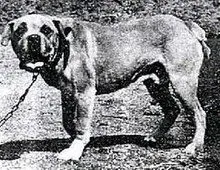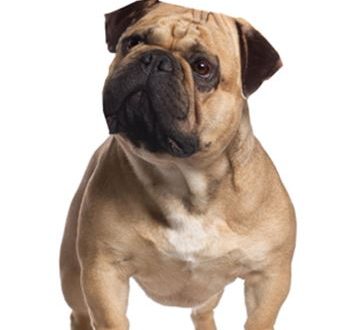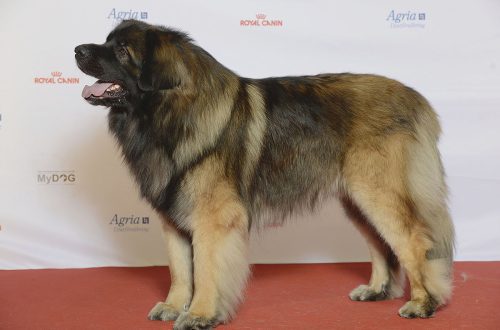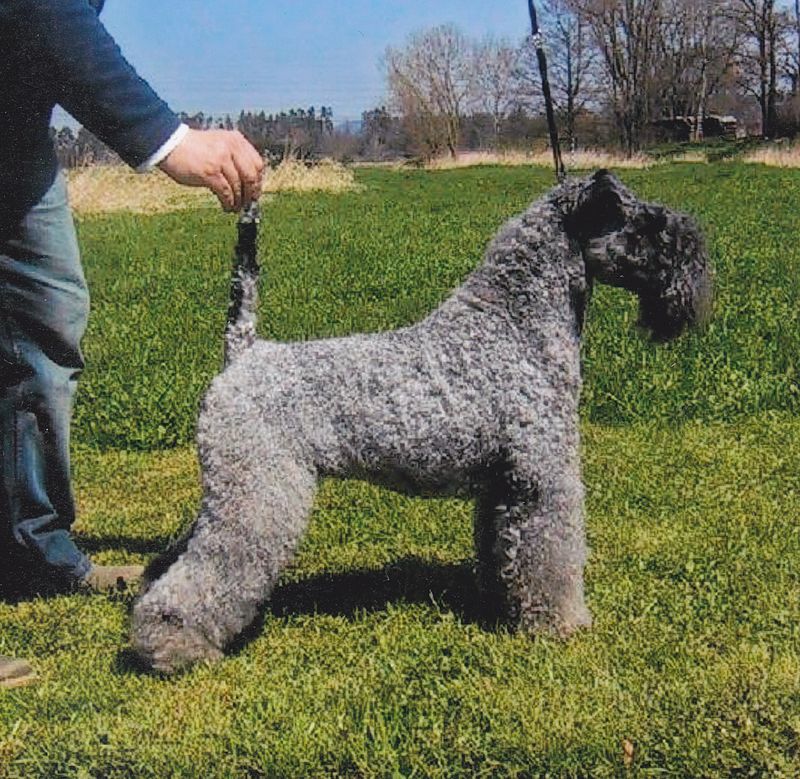
Kerry Blue Terrier
The Kerry Blue Terrier is a medium-sized dog with an exquisite blue coat color. The breed was named in honor of its homeland – the Irish county of Kerry.
Contents
- Characteristics of Kerry Blue Terrier
- Basic moments
- History of the Kerry Blue Terrier
- Video: Kerry Blue Terrier
- Kerry Blue Terrier Breed Standard
- Personality of the Kerry Blue Terrier
- Education and training of Kerry Blue Terrier
- Maintenance and care
- Health and disease of Kerry Blue Terriers
- How to choose a puppy
- Kerry blue terrier price
Characteristics of Kerry Blue Terrier
| Country of origin | Ireland |
| The size | Average |
| Growth | 44–49 cm |
| Weight | 15–18 kg |
| Age | about 15 years |
| FCI breed group | Terriers |
Basic moments
- The owners of the Kerry Blue Terrier will have to comprehend the basics of professional grooming, since molting, accompanied by a phased loss of the dog, is not typical for the breed.
- The hunting instinct of the blue-haired “Irish” is sharp enough that it prevents the dogs from peacefully coexisting with their fellow tribesmen, as well as any animals inferior to them in size.
- Representatives of this family are playful, but do not suffer from hyperactivity and excessive workaholism. Optimal outdoor entertainment for a pet is frisbee, fetching objects, swimming.
- The breed will especially appeal to people who dream of a “family” dog, who equally loves all household members and is not obsessed with one person.
- Most Kerry Blue Terriers have classic terrier habits – a mania for trapping rodents, digging in vegetable gardens and flower beds.
- The inclinations of a leader and leader are inherent in all representatives of the breed, therefore, for too soft owners who do not bother to train a puppy, Kerry transforms into impudent and destructive pets.
- The Kerry Blue Terrier retains good physical condition and an interest in life and play into old age.
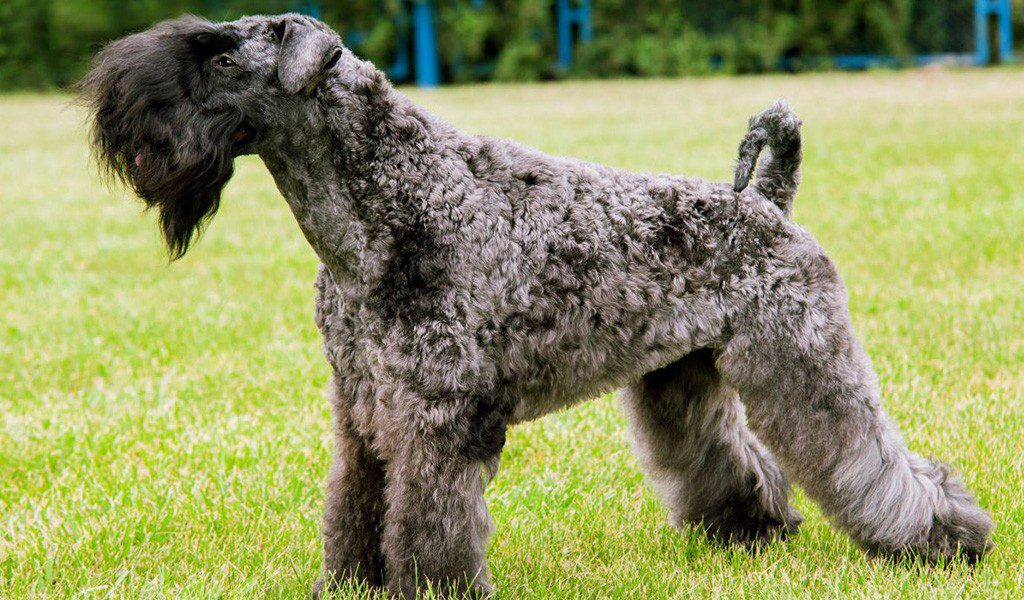
The Kerry Blue Terrier is a temperamental bearded man with hipster bangs, bringing confusion and chaos to any dog pack, but radiating endless good nature in the company of the owner. To make friends with a shaggy “Irish”, no superpowers are required – representatives of this breed are loyal to any person with whom they have to share territory. However, if you are visiting a Kerry Blue Terrier for the first time, precautions will not hurt – dogs are reservedly cold in communication with strangers and do not try to disguise suspicion of strangers.
History of the Kerry Blue Terrier
The Kerry Blue Terrier is a dog with an impressive but not very coherent history. Experts still cannot establish the true ancestors of animals and are limited to unconfirmed guesses about the degree of relationship of Kerry Blue Terriers with other breeds. For example, it is generally accepted that the first bearded dogs were born from mating Irish wolfhounds with black and tan English terriers, which were later replaced by Bedlingtons and wheaten terriers. At the same time, the Irish, greedy for legends and sensations, continue to believe that the progenitor of the breed was a Portuguese water dog of blue color, who escaped from a sinking Spanish ship and was picked up by farmers of the Emerald Isle.
In the 19th century, the possession of a Kerry Blue Terrier was a must for Irish peasants. However, practical villagers did not want to keep animals “for beautiful eyes”, therefore, any feasible work was imposed on four-legged pets – catching water rats, grazing sheep flocks, and protecting the master’s property. Kerry Blue Terriers began to master breed exhibitions at the very end of the 19th century. Along the way, the dogs were involved in the passage of field trials, in which they achieved good results. As a result, it got to the point that the dog, which did not show its success in the extraction and supply of the animal at the exhibition, could not claim the champion title. But enterprising breeders got their bearings here too, starting to deliberately cultivate viciousness in their wards, for which Kerry received the nickname “blue devils”.
In the 20s of the XX century, Kerry Blue Terriers were standardized, and their owners began to unite in clubs. In 1922, the “Irish” were registered in England, two years later the American Kennel Club did the same procedure. The breed entered the USSR in the 60s. Basically, these were individuals from Germany, which periodically flashed at all-Union exhibitions and even brought offspring. As for the formation and pumping of the Russian lines of carry, it is customary to call the Soviet breeding specialist A.I. Kozlovsky a pioneer. On his initiative, the first in the USSR collective kennel of the Irish Hippie breed was created, from which several generations of healthy, spectacular outwardly and mentally stable champions came out.
Video: Kerry Blue Terrier
Kerry Blue Terrier Breed Standard
Historically, Kerry Blue Terriers were typical farm dogs that were kept not for purity of blood, but for helping with household chores. Therefore, despite a century of exhibition breeding, peasant solidity, and sometimes outright coarseness of addition, still slips in the appearance of the breed. Abundant wavy hair helps to hide anatomical imperfections, thanks to which the Kerry look smart, elegant and extraordinary.
Sexual dimorphism for smoky “Irish” is also a typical phenomenon – usually males have more powerful muscles and massive heads. Growth lag in females is small: if the reference “boy” must be at least 45.5-49.5 cm at the withers, then for “girls” the ideal indicators are 44.5-48 cm. At exhibitions, strict requirements are imposed on the shape of the head and texture of the coat of the Kerry Blue Terrier. They also get the highest score. By the way, if you do not look closely at the animal, it may seem that its coat is curly. In fact, the excessive “poodleness” of the dog is a serious drawback. A true Kerry’s hair is wavy and soft, but by no means kinky.
Head
The skull is rather large, balanced, with a light stop. The muzzle is medium in size.
Teeth and jaws
The correct representative of the breed is distinguished by large strong teeth and a scissor bite. A direct closure of the dentition is also allowed. The dog’s jaws are strong and prehensile. The mouth and upper and lower gums should be black.
Nose
The harmoniously developed lobe is jet black and has large, wide-open nostrils.
Eyes
Eyes of medium size, normal shallow set, with a dark hazel or just a dark iris. The look of the Kerry Blue Terrier is piercingly intelligent.
Ears
Neat thin ears are held on the sides of the head, forming a fold in their middle part and falling forward. In order for the ear cloth to take the correct position, it is glued on for Kerry Blue Terrier puppies. Ears begin to glue from the age of three months and finish when the animal is seven months old. In some individuals, the process of cartilage tissue formation may be delayed. This is also normal, but it takes longer to glue such “stubborn” ears.
Neck
The necks of the Kerry Blue Terriers are neither too long nor too short, with strong bases.
Frame
The thoroughbred Kerry Blue Terrier is a stately pet, with relief muscles and strong bones. Ideally horizontal, of normal length, the back is “reinforced” by a strong lower back. The chest of the animal is characterized by normal width and pronounced depth with rounded ribs.
Kerry Blue Terrier limbs
The front legs of the dog in the stance are characterized by a straight position, as well as a harmonious solidity of the skeleton and muscles. The shoulder blades are oblique, with clear outlines and a good fit to the sides. The hind limbs are distinguished by a set under the body, large hips and hardy hocks. Kerry Blue Terriers have small paws, but with very well developed, dense pads. The animal moves easily, extending the front legs wide and making a powerful push with the hind legs. At the same time, the head and tail of the running carry are carried as high as possible, and the back remains straight.
Tail
The representatives of the breed have a very thin, straight, well-set tail.
Kerry Blue Terrier Wool
The hair is lush, moderately soft and wavy. The coat on the head and muzzle is especially developed.
Color
The coat of adult Kerry Blue Terriers is colored in all shades of blue, and may also have black marks on the body. At the same time, all individuals are born black, gradually “lightening” by 1-1.5 years.
Disqualifying vices
Animals cannot be exhibited in show rings if they have pronounced exterior defects:
- overshot or undershot bite;
- gums “meat” color;
- yellow or lightened tone of the iris;
- convex or saddle back;
- excessively narrow chest;
- elbows separated from the body;
- dewclaws on hind feet, even if they were once removed;
- cow or stilted gait, not characteristic of the breed;
- any coat color other than that specified by the standard;
- hard, bristly dog.
Individuals with an unstable psyche, demonstrating aggression or behaving cowardly, do not pass the exhibition selection and are disqualified. In addition, penalties are imposed on dogs that have to be helped to make the correct stance (raise the tail and head) during the exhibition.

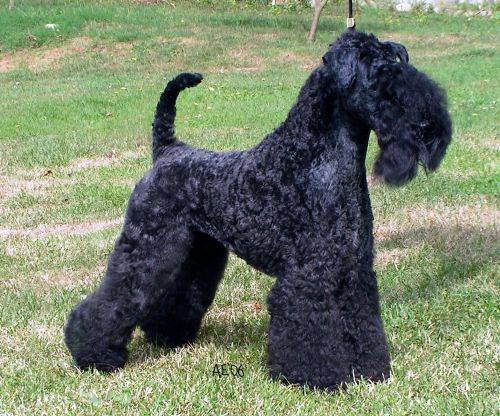

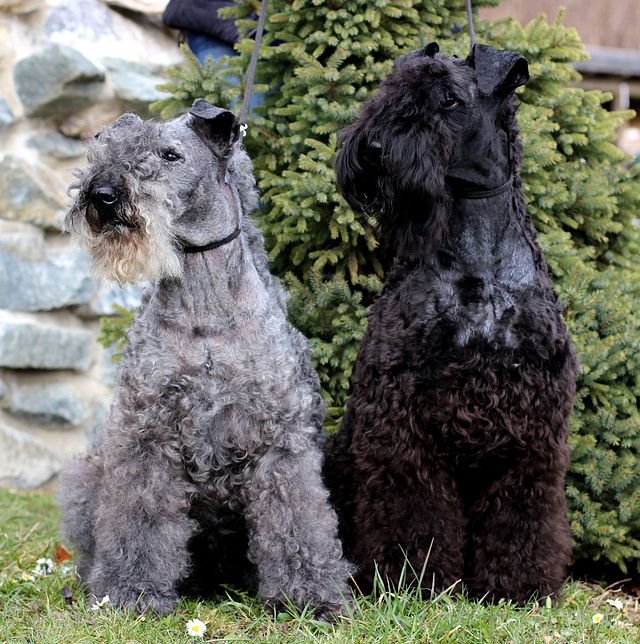
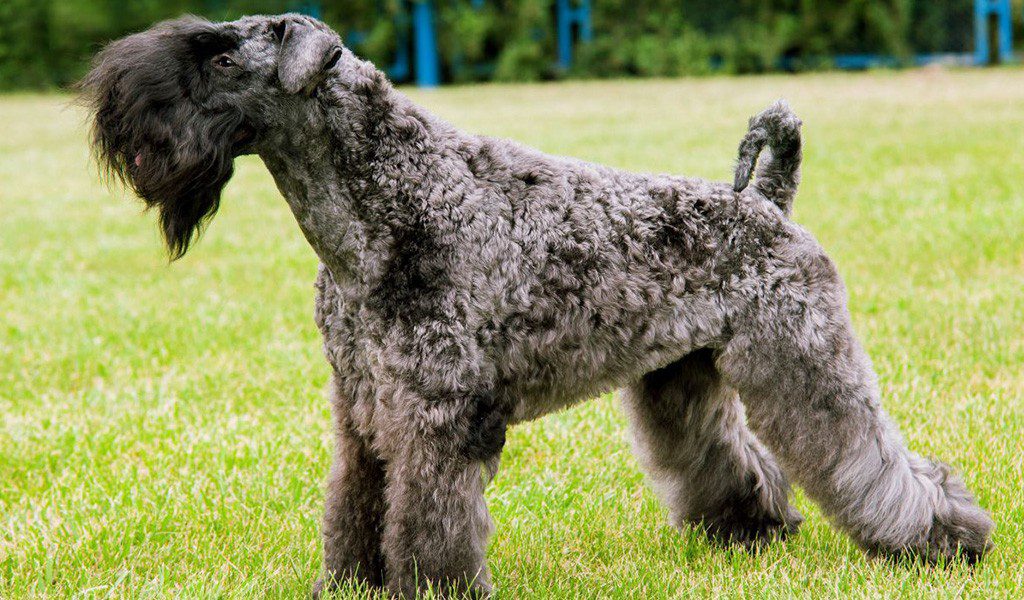
Personality of the Kerry Blue Terrier
Describing the character of the Kerry Blue Terriers, it is customary to quote E. S. Montgomery, who argued that the breed is distinguished from the inhabitants of Ireland only by the fact that its representatives do not smoke pipes. In all other respects, the “sparkling” temperament of animals completely copies the mentality of the inhabitants of the Emerald Isle. Playful, winding up from a half turn, adoring reckless fun and the same fights, Kerry Blue Terriers are the type of pets with which all life passes in anticipation of a surprise.
A real Kerry Blue Terrier is, first of all, a human-oriented creature. A puppy brought into the house quickly joins the family and learns to get along with each of its members, without appointing one person as a confidant. Children for an animal are pleasant companions and playmates. By the way, unlike dogs of large breeds, Kerry does not see children and adolescents as a lower caste, whose representatives should be treated condescendingly, but whose demands should not be responded to. Moreover, the natives of green Erin will gladly go with your heirs to the training ground and heed the commands given by the young masters.
But with fellow tribesmen, Kerry Blue Terriers have mutual understanding “for C grade”. Maybe because, seeing another dog, the “Irish” will not miss the opportunity to show off and demonstrate his own invincibility. Actually, 90% of conflicts with four-legged brothers begin with such provocations: the carry teases, the enemy makes a warning “Rrr!” – and a senseless fight flares up. There is an opinion that Kerry Blue Terriers are desperate cat-haters, but clarification is required here: dogs only chase unfamiliar kitties. Purr, from an early age sharing a living space with a dog, has the right to count on indulgence.
As for the watchdog abilities of the breed, it is quite possible to rely on them. True Kerry Blue Terriers do not suffer from idle talk, and if they bark, then really about it. Of course, we are not talking about ill-mannered pets using their voice for the sake of boredom. Some carries are able to let a stranger into the house, but certainly not let him out. Usually the dog blocks the exits from the premises and carefully studies the behavior of the stranger. The reaction to any threatening gesture (a wave of the hand, an attempt to push the tailed watchman away with a kick) should be harsh and immediate. By the way, the bites of the breed are painful and deep.
The Kerry Blue Terrier is incredibly jumpy and morbidly curious, so there are no forbidden places in the apartment for him, there are simply underexplored ones. At the same time, he is neat in everyday life, and even despite the habit of chewing something solid at his leisure, he does not suffer from destructive behavior and does not have fun with howling. In the absence of the owner, the pet is able to find a peaceful occupation or take a sweet nap on the carpet until one of the family members appears in the house. And the Kerry Blue Terrier is a born humorist, easily transforming into a clown with a wild imagination and an inexhaustible supply of practical jokes. Be mentally prepared for funny tricks, strange tricks with surrounding objects and amusing pantomime with the participation of a four-legged minion.
Education and training of Kerry Blue Terrier
Each Kerry Blue Terrier is a bright individual, so even an experienced cynologist cannot predict how easy it will be to train a particular puppy. However, almost all trainers note the breed’s innate stubbornness when it comes to forcing classes. The reason for the stubbornness lies in the fact that it is difficult for a carry to concentrate on things that seem obviously boring to him. In addition, this comrade constantly switches to external stimuli, such as a slithering mouse or a tribesman looming on the horizon. So you need to work out teams and sports skills with the breed quickly (a 10-minute exercise is the limit), persistently, but without unnecessary authoritarianism.
The boundaries of socialization and acquaintance of the pet with the surrounding reality on a walk should be corrected by a leash (not a harness). Do not forget, “Irish” like to provoke conflict situations with other dogs. Kerry Blue Terriers are raised using standard methods. First, the puppy is taught to a single daily routine, the ability to respond to his own nickname and elements of etiquette. Attempts to attack a person, biting, growling, and in general any demonstration of superiority must be stopped. Carries are typical dominants, who only need to yield once so that they have time to sit on the owner’s head.
The first commands in the life of every Kerry Blue Terrier are “Place!”, “No!” and “To me!”. The easiest way to teach a puppy to go to his corner is to take him there after eating and, holding the animal with his hands on the couch, pronounce the command (“Place!”) Quietly but convincingly. How to properly practice the call and other basic orders can be found in the training books “Don’t growl at the dog” by K. Pryor, “The ideal dog does not walk the owner” by M. Rutter, “Dog without problems”, as well as “Dog obedience » V. Gritsenko. Remember that at the beginning of training, calling an animal for punishment or to take it away from a walk is a gross mistake. The Kerry Blue Terrier is not such a simpleton as to obey a command that limits his entertainment.
Punishments in a pet’s life should take place when he is caught red-handed. There should be no retroactive “repressions” or beatings. They are also not punished for not understanding the requirements, being afraid of something, or for too slow execution of commands. It is not recommended to capture the Kerry Blue Terrier to prevent him from doing what you do not like, as well as spanking the dog with a leash. In the first case, the animal will perceive “catching up” as a fun game, not forgetting to write off one hundred points from your authority. And in the second, he will quickly realize that there is a danger to the sides in the strap, and in the future he will not allow himself to be fastened.
Maintenance and care
Modern Kerry Blue Terriers are in every sense domestic dwellers. They are not demanding on space and are content with a modest couch somewhere in the corner, provided that the sun penetrates there and does not blow out a draft. Both in puppyhood and at quite a respectable age, the “Irish” love to sharpen their teeth on objects. To do this, buy special toys for your pet and periodically update them – rubber balls and squeakers cannot withstand the sharpness of dog teeth for a long time. From time to time, toys can be replaced with raw vegetables – carrots, cabbage leaves and other “useful things”.
It is important to monitor the legs and posture of the puppy. For the first 6 months of life, Kerry Blue Terriers are not allowed to go up and down stairs on their own. You can’t also play “tug” with the dog – it’s easy to distort the animal’s bite during such entertainment, but it’s almost impossible to fix it. Adults should be walked twice a day, spending at least two to three hours on promenades and sports exercises. Puppies are taken out to breathe and to satisfy their toilet needs up to 5 times a day. When the pet reaches 6 months of age, the number of excursions is reduced to three.
Hair cutting and hygiene
The wool of the Kerry Blue Terrier is not harmed by frequent bathing, so in the warm season you can swim with your dog in open water at least every day. As for a full wash with shampoos and conditioning compounds, it is permissible to arrange it once a week or two. It is advisable to comb the kerry more often. Breeders recommend brushing through the puppies’ coat daily to speed up the process of changing junior hair. Adults are recommended to be massaged with a metal comb at least twice a week.
To maintain the glamorous look of the dog’s “fur coat” hair is supposed to be cut regularly – trimming is contraindicated for the breed. The cutting process is carried out in the following sequence:
- comb the wool, sorting out the tangles, if any;
- wash the dog with shampoo for dry hair;
- let the pet dry naturally – the hair dryer is not used at all, or it is used, but the hair is not combed during the drying process;
- comb completely dried wool against growth.
Ideally, the Kerry Blue Terrier should adopt a show stance, which will make grooming easier, but in practice it can be dispensed with. The main thing is to teach the dog to calmly respond to the procedure. The first haircut for puppies is done at 3 months of age, and then as the hair grows.
Important: Kerry Blue Terriers are not sheared on the eve of the show. It is necessary to carry out the procedure at least 3 weeks before entering the ring, so that the hair has time to grow and the transitions to even out.
Shearing the dog starts from the head. First, the outer and inner parts of the ears are cut with a machine, and their edges are carefully processed with scissors. A thick bang is formed above the eyes. The hair of the parietal zone is shortened either with a machine or with scissors, leaving a neat wave of hair on the forehead with a length of no more than 1 cm. The areas of the temples, throat and areas from the sides of the eyes are cut very short.
The hair on the back is removed with scissors, lifting it against growth with a metal comb. The optimal length of the coat on this part of the body is from 2 to 5 cm. The same length is preferred on the sides and chest. The neck is also treated with scissors in the direction from the back of the head to the withers. It is important to make the transition as smooth as possible, since as the neck approaches the forearms, the length of the hair should increase.
The outer part of the tail continues the line of the back and is cut according to the same principle. But on the inside of it, the dog needs to be shortened as much as possible. Particular attention – the area under the tail. The coat around the anus should be very short. Otherwise, waste products will stick to regrown curls.
For show individuals, the hair on the legs and lower part of the chest is not cut, but carefully combed first down, then against growth. Although pets, especially young ones, trim limbs will not hurt. The beard and mustache, which are very lush in Kerry Blue Terriers, require special care. The hair in the corners of the mouth is usually removed, and too thick hair on the muzzle is milled with scissors. The hairs between the fingers and on the bottom of the paws are removed, forming a rounded contour. On the outer part of the fingers, the hair is not removed.
Gross Grooming Mistakes:
- cutting hair under the eyes of the Kerry Blue Terrier;
- groin cutting;
- leaving long hair on the head, sides, muzzle and abdomen.
Increased attention is necessary for the organs of vision of the pet. Like most breeds with “woolen” muzzles, the eyes of the Kerry are slightly leaking, which is especially evident in puppyhood, as well as in individuals with overgrown, unkempt bangs. Every day, the folds of the eyelids and the eyeballs of the dog must be wiped with a cloth dipped in warm water. It is also acceptable to use drops from excessive lacrimation, such as “Diamond Eyes”.
Once a week, you need to check the ears of the Kerry Blue Terrier and remove excess sulfur from them, if any. The procedure will require a clean cloth (no cotton swabs) and any hygienic lotion for the ears of dogs. In addition, get ready to systematically pull out abundantly overgrown hair from the ear funnel, which reduces hearing acuity and provokes inflammation. This will have to be done manually, in several steps.
Hygiene of the Kerry beard and mustache is an obligatory item in the care of the breed. At home, it is better to pull the hair on the chin loosely with an elastic band. So it will be more convenient to wipe it after each feeding. Once every two weeks, the dog is entitled to a “pedicure”. After cutting the nails, it is also useful to grind the plate with a nail file.
The teeth of the Kerry Blue Terrier should be cleaned with a brush and veterinary toothpaste. But if the animal is not accustomed to such a procedure, the problem will have to be solved in alternative ways. For example, adding tomato juice to your pet’s food or chewing treats from a pet store.
Feeding
It is better to feed the Kerry Blue Terrier according to the regimen, organizing meals so that the dog is in good condition, but not fat. From natural products for the breed are optimally suited:
- raw lean meat – beef, horse meat, goat meat, lamb;
- raw or boneless fish stewed in oil – hake, navaga, cod, but not more than 2 times a week;
- low-fat kefir, cottage cheese, occasionally cheese;
- once a week chicken egg – boiled protein and raw yolk;
- vegetables and fruits, except legumes;
- cereal porridge – buckwheat, rice;
- young greens – nettle, dandelion leaves, lettuce, parsley;
- vitamin supplements and treats – seaweed, sauerkraut, dried fruits.
It is forbidden to treat a puppy with tubular and bird bones, but sometimes you can allow a little pampering in the form of lamb ribs. Meat for Kerry Blue Terriers is always cut into pieces, but never minced. They serve cold cuts for breakfast and dinner.
In addition, it is important to remember that up to a year, Kerry Blue Terriers require mineral supplements and ready-made vitamin complexes. They do not buy dietary supplements only for individuals who have been eating dry food (of course, high quality) from the first months of life. The frequency of feeding the Kerry Blue Terrier: up to 4 months – four times a day, from 4 months to six months – three times a day, from 6 months onwards – two meals a day.
Health and disease of Kerry Blue Terriers
The average life expectancy of the breed is 13 years. However, with good care, many individuals are able to overcome this age bar. There are also cases when the “Irish” ended their life at the age of 18. Kerry are less susceptible to hereditary diseases than most purebred tribesmen. For example, joint dysplasia, which affects many large and medium dogs, occurs in a very small number of Kerry Blue Terriers. But the “Irish” periodically experience subluxation of the joints, which can be caused both by the consequences of the injury and genetically.
Hypothyroidism, as well as von Willebrand and Addison’s diseases, also occur among immigrants from the Emerald Isle, but not as often as one might expect. The real problem for the breed is progressive neural abiotrophy. The disease is not treated, it is inherited, but it is not yet possible to determine its carrier. The disease manifests itself in 2-6-month-old puppies, and by the year the animals are completely immobilized.
Kerry blue terriers are also found to have dry keratoconjunctivitis, as well as a tendency of integument to form epidermal cysts. In the first case, the disease can become chronic, and in the second case, the growths on the skin often become infected. Not exactly a disease, but quite an unpleasant thing – calluses on the pads and between the toes. They are formed more often in the “Irish” than in other dogs, provoking lameness.
Of the eye pathologies, the Kerry Blue Terriers “got” entropion and juvenile cataract. Inflammation of the middle ear is another common disease of the breed. Most often, individuals whose owners are too lazy to systematically clean their ears and pluck out overgrown hair from them suffer from it.
How to choose a puppy
Do not forget that all representatives of the breed are born with a black coat color. If you are afraid of being deceived by the seller, get ready to buy one and a half year old individuals – by this age, Kerry Blue Terriers acquire the traditional blue color.
- Choose suburban kennels where dogs lead a relatively free lifestyle, and are not locked in four walls by ruthless breeder sellers.
- Specify what kind of food the breeder gives to his wards. If this is a cheap “drying”, do not expect to get a healthy animal from such an “economical” specialist.
- Assess the overall well-being of the litter. Are the puppies thin, how clean is their coat and areas under the tail, are there fleas on the body.
- Even if the Kerry Blue Terrier is not bought for shows, check out the pedigree of his parents. This will allow you to better know the potential of the future pet.
- Not always predisposition to hereditary diseases can be diagnosed in advance. But if a breeder reports that his studs have been tested for at least genetic joint dysplasia, this is a big plus.
Kerry blue terrier price
A club puppy of a Kerry Blue Terrier in Russia costs about 500$. A native of European nurseries (England, Scotland) will cost 1200-1500 euros, depending on exterior qualities and health.



